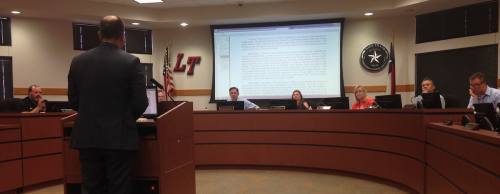After 4 1/2 years of assessing facilities and studying projected growth patterns in Lake Travis ISD, the district’s board of trustees on June 20 approved a $253 million bond package, which should not raise the district’s property tax rate, to be voted on by residents Nov. 7.
The bond focuses on addressing continued population growth in the district as well as renovating some of LTISD’s older facilities, Bond Advisory Committee Chairman Jeremy Self said. This includes building the district’s third middle school and seventh elementary school, purchasing new buses, improving infrastructure districtwide and purchasing land for future growth.
If approved by voters, the bond will not have an impact on the local tax rate because the district has been able to pay off its previous debt early, Superintendent Brad Lancaster said.
“If the bond election passes, your tax rate won’t change, and the district gets $253 million to build and improve schools,” he said. “That’s a rare feat.”
bond details
Due to the increase in property values since 2011, when the district’s last bond was approved, Lancaster said the district has been able to pay down its debt early, resulting in a savings of $40 million in interest over the past six years.
Johnny Hill, LTISD’s assistant superintendent of business, financial and auxiliary services, said this long-term approach to paying off debt early allows the district to call the bond without increasing the tax rate. If the district had not been ahead on its payments, the tax rate would likely need to be increased by 16 cents per $100 valuation to accommodate the bond, he said.
The $253 million bond package was created by the bond advisory committee based on a list of district requests that totaled about $392 million, said Johnny Hill, LTISD assistant superintendent of business, financial and auxiliary services.
The committee was tasked to cut down the requests to about $255 million, which would allow the district to maintain its current tax rate while still addressing the district’s highest needs, Self said.


“Based on the data we saw from assessments of district facilities, technology, furniture and food services, we provided a prioritization,” he said. “We, in good conscience, can [say] these items are needed by the district.”
Addressing LTISD growth
Lancaster said the bond’s big-ticket items include the district’s new middle school, set to be located on Vail Divide outside the Falconhead West subdivision, and the new elementary school, set to open in the Rough Hollow area on Bee Creek Road. The bond assigns $73,880,710 and $31,511,000 to these projects, respectively.
“We work very closely with our demographers, but one thing we notice in our district is the growth is not spread evenly [between grades] K-12,” Hill said. “More of our growth is hitting the high school and middle school grades than the elementary grades.”
Lake Travis Middle School, which has a maximum capacity of 1,250 students, has an enrollment of 1,411 students this year, he said. If the bond is approved, construction of the new middle school would begin in December and could be completed by the start of the 2019-20 school year, giving the area much-needed relief, Hill said.
If approved by voters, the new elementary school would be set to open for the 2020-21 school year.
The district has also allocated $19 million for land acquisition for future school sites that will be needed to address growth, Lancaster said.
Approximately 84 total buses would be purchased through the bond for $8,770,000. An estimated 39 current buses will be replaced with new models, 20 new buses will be added the to LTISD’s fleet as new bus routes, and the remainder will be used for special education and other uses.
“Every other district I’ve been in had bus ridership between 30 and 35 percent,” Lancaster said. “We jumped to 50 percent ridership this year, and I think a lot of it is that traffic is so bad in the area.”
Hill said as density in the district increases, the additional buses will make the LTISD service more convenient for parents.
Self said as the district adds new bus routes, bus rides will get shorter for students, and parents will be more likely to rely on the service.
Approximately $51 million will go to the district’s existing schools. About $36 million of the bond will be used to address aging infrastructure, such as roofing, air conditioning, plumbing and electrical work as well as improve fire safety, Hill said.
“People forget that our district is about 30 years old and, after 30 years, the infrastructure needs to be addressed,” Hill said. “Our district has never spent a whole lot of money on infrastructure, but it is getting to the age now where we are having to go back and work on the buildings we already have.”
What if the bond fails?
If voters do not approve the bond this fall, Lancaster said the board would likely try to get a smaller bond package approved in a May 2018 election, prioritizing new schools.
“[The district is] going to be super crowded by the fall of 2019,” he said. “If we have to wait for an election in May, we wouldn’t be opening Middle School No. 3 until fall of 2020.”
Delaying the campus by a year would force the district to purchase portables as a stopgap measure, which could cost up to $100,000 per portable, Lancaster said.
“If we don’t pass this bond we’ll have 1,800 kids sitting at Lake Travis Middle School, which is designed for 1,250 students,” Hill said. “We’re trying to limit portables because they’re expensive. We’re trying to be as efficient as we can.”






